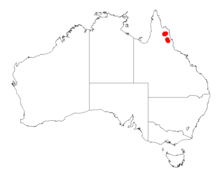| Acacia johannis | |
|---|---|
| Scientific classification | |
| Kingdom: | Plantae |
| Clade: | Tracheophytes |
| Clade: | Angiosperms |
| Clade: | Eudicots |
| Clade: | Rosids |
| Order: | Fabales |
| Family: | Fabaceae |
| Subfamily: | Caesalpinioideae |
| Clade: | Mimosoid clade |
| Genus: | Acacia |
| Species: | A. johannis
|
| Binomial name | |
| Acacia johannis | |

| |
| Occurrence data from AVH | |
Acacia johannis is a shrub of the genus Acacia and the subgenus Plurinerves that is endemic to a small area of north eastern Australia.
Description[edit]
The shrub typically grows to a height of around 2 m (6 ft 7 in) and has red-brown coloured glabrous and lenticellate branchlets. Like most species of Acacia it has phyllodes rather than true leaves. The evergreen, glabrous and sickle shaped phyllodes have a narrowly elliptic shape and are 14 to 18 cm (5.5 to 7.1 in) in length and 5 to 14 mm (0.20 to 0.55 in) wide and have three or four prominent longitudinal nerves with indistinct secondary nerves. It blooms in February and April producing simple inflorescences that occur singly or in pairs with flower-heads that contain 50 lemon-yellow coloured flowers.[1]
Taxonomy[edit]
The species was first formally described by the botanist Leslie Pedley in 1999 as part of the work Notes on Acacia (Leguminosae: Mimosoideae) chiefly from northern Australia as published in the journal Austrobaileya. It was reclassified by Pedley in 2003 as Racosperma johannis then returned to genus Acacia in 2006.[2]
Distribution[edit]
It has a limited distribution in far north Queensland around Mount Mulligan where it is known to form dense thickets. It is commonly situated on and among rock pavements and outcrops growing in sandstone based shallow rocky soils.[1]
See also[edit]
References[edit]
- ^ a b "Acacia johannis Pedley". Wattle - Acacias of Australia. Lucid Central. Retrieved 30 November 2020.
- ^ "Acacia johannis Pedley". Atlas of Living Australia. Global Biodiversity Information Facility. Retrieved 30 November 2020.